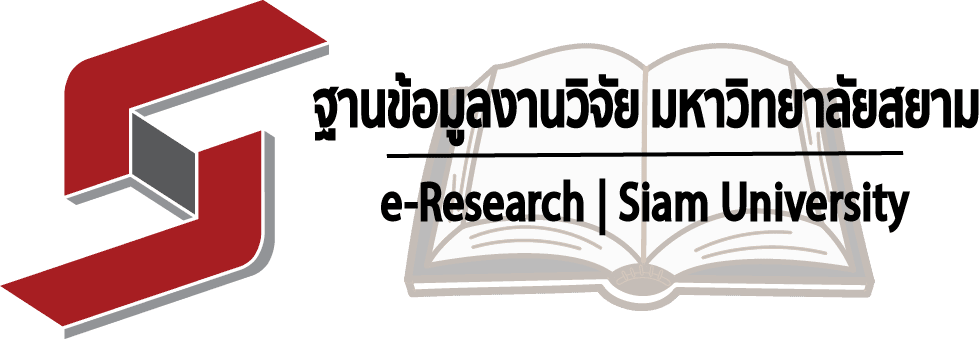- KB Home
- หลักสูตรระดับบัณฑิตศึกษา|Graduate Schools
- หลักสูตรปริญญาโท|Masters Degree
- MPA
- การบริหารจัดการขยะมูลฝอยของสำนักงานเขตบางขุนเทียน
| หัวข้อสารนิพนธ์: Project Title: |
การบริหารจัดการขยะมูลฝอยของสำนักงานเขตบางขุนเทียน A Study of Solid Waste Management Practices of Bang Khun Thian District Offices |
| ชื่อนักศึกษา: Author: |
นางรัชกร วัฒนพันธ์ Mrs. Ratchakorn Watthanapun |
| อาจารย์ที่ปรึกษา: Advisor: |
ดร.สุเมธ แสงนิ่มนวล Dr. Sumet Saengnimnuan |
| ระดับการศึกษา: Degree: |
รัฐประศาสนศาสตรมหาบัณฑิต (รป.ม.) Master of Public Administration |
| สาขาวิชา: Major: |
รัฐประศาสนศาสตร์ Public Administration |
| คณะ: Faculty: |
บัณฑิตวิทยาลัย Graduate Schools |
| ปีการศึกษา: Academic year: |
2562 2019 |
| URL: Published แหล่งเผยแพร่ผลงาน |
Conference Conference Proceedings National and International Academic Conference “Innovation and Management for Sustainability” 9-10 July 2020 |
การอ้างอิง/citation
รัชกร วัฒนพันธ์. (2562). การบริหารจัดการขยะมูลฝอยของสำนักงานเขตบางขุนเทียน. (การค้นคว้าอิสระรัฐประศาสนศาสตรมหาบัณฑิต). กรุงเทพฯ: บัณฑิตวิทยาลัย มหาวิทยาลัยสยาม.
บทคัดย่อ
การวิจัยครั้งนี้เป็นการศึกษาแนวทางการบริหารจัดการขยะมูลฝอยของสำนักงานเขตบางขุนเทียน โดยมีวัตถุประสงค์ 1) เพื่อศึกษาการบริหารจัดการขยะมูลฝอยของสำนักงานเขตบางขุนเทียน 2) เพื่อศึกษาถึงปัญหาอุปสรรค และข้อเสนอแนะในการแก้ไขปัญหาเกี่ยวกับการจัดการขยะมูลฝอยภายในพื้นที่เขตบางขุนเทียน ซึ่งเป็นการศึกษาวิจัยเชิงคุณภาพโดยใช้การสัมภาษณ์แบบกึ่งโครงสร้างกับข้อคำถามแบบปลายเปิดเป็นเครื่องมือในการเก็บข้อมูลจากกลุ่มตัวอย่างในพื้นที่เขตบางขุนเทียน จำนวน 2 กลุ่มตัวอย่าง ได้แก่ กลุ่มเจ้าหน้าที่ฝ่ายรักษาความสะอาดและสวนสาธารณะ สำนักงานเขตบางขุนเทียน จำนวน 2 คน ซึ่งเป็นผู้ควบคุม กำกับดูแลด้านการเก็บขนมูลฝอยในพื้นที่เขตบางขุนเทียน กลุ่มที่ 2 ประธานชุมชนพื้นที่เขตบางขุนเทียน จำนวน 4 คน คัดเลือกจากลักษณะพื้นที่ของเขตบางขุนเทียนที่มีจำนวน 2 แขวง ประ ในแต่ละแขวงจะมีลักษณะของพื้นที่ต่างกัน เช่น แขวงแสมดำ ลักษณะของพื้นที่เป็นกึ่งเศรษฐกิจเป็นที่ตั้งของบริษัท ห้างสรรพสินค้า และโรงพยาบาลขนาดใหญ่ เนื่องจากอยู่ติดกับถนนพระรามที่ 2 สำหรับแขวงท่าข้ามเป็นพื้นที่กึ่งชนบทเป็นเขตติดต่อกับจังหวัดสมุทรสาคร ลักษณะของพื้นที่เป็นหมู่บ้านจัดสรรโรงงานอุตสาหกรรม ร้านจำหน่ายอาหารทะเลถนนบางขุนเทียน-ชายทะเล พื้นที่ประกอบอาชีพเกษตรกรรม และอาชีพการประมง
ผลการวิจัยพบว่า การบริหารจัดการขยะมูลฝอยของสำนักงานเขตบางขุนเทียน ดำเนินการตามแผนปฏิบัติราชการสำนักงานเขตบางขุนเทียน ซึ่งนำกรอบแนวทางมาจากแผนปฏิบัติราชการกรุงเทพมหานครประจำปีงบประมาณ และแผนปฏิบัติราชการกรุงเทพมหานคร ระยะ 20 ปี (พ.ศ. 2556 – 2575) โดยการดำเนินงานแบ่งออกเป็น 3 ส่วน ได้แก่ 1) การลดและการคัดแยกขยะมูลฝอย เป็นการจัดโครงการหรือกิจกรรมต่าง ๆ เพื่อรณรงค์ประชาสัมพันธ์ส่งเสริมให้ภาคประชาชนมีการลดปริมาณขยะมูลฝอยจากแหล่งกำเนิด 2)การรวบรวมและขนส่งเป็นการบริหารจัดการเส้นทางการจัดเก็บขยะให้ครอบคลุมทั่วพื้นที่ โดยใช้ระบบสารสนเทศภูมิศาสตร์ (Geographic Information System : GIS) มาวิเคราะห์กำหนดเส้นทาง ไปพร้อมกับการลงพื้นที่กำกับควบคุม ดูแล การจัดเก็บขยะมูลฝอยของเจ้าหน้าที่เก็บขนมูลฝอย โดยเน้นให้ประชาชนได้รับบริการที่ดีสุด ต้องบริหารจัดการไม่ให้มีปัญหาทั้งในเรื่องของความสกปรก กลิ่นเหม็น ขยะตกค้าง และการกีดขวางการจราจร 3) การกำจัดขยะมูลฝอย เป็นการลำเลียงขนส่งมูลฝอยภายในพื้นที่ไปยังสถานีขนถ่ายมูลฝอยหนองแขม เพื่อนำเข้าสู่กระบวนการกำจัดขยะของกรุงเทพมหานคร
ข้อเสนอแนะที่ได้จากการวิจัยจากการสัมภาษณ์แบบกึ่งโครงสร้าง โดยใช้ข้อคำถามแบบปลายเปิด พบว่าพฤติกรรมของประชาชนส่วนใหญ่ตระหนักรู้และรับทราบถึงประโยชน์ของการคัดแยกขยะจากแหล่งกำเนิดซึ่งนอกจากเพิ่มรายได้จากการขายขยะรีไซเคิล ยังเป็นการช่วยลดปริมาณขยะ และงบประมาณกรุงเทพมหานครที่ต้องใช้ไปกับเรื่องกำจัดขยะมูลฝอยได้มากขึ้น ซึ่งสามารถนำงบประมาณมาใช้พัฒนาพื้นที่ได้เพิ่มขึ้น เพราะเจ้าหน้าที่สำนักงานเขตบางขุนเทียน จัดโครงการ / กิจกรรม ลงพื้นที่ให้คำแนะนำเรื่องการจัดพื้นที่ส่วนกลาง เพื่อเป็นศูนย์รวบรวมการคัดแยกประเภทขยะและนำขยะกลับไปใช้ประโยชน์ แต่ปัญหาที่ประชาชนต้องการให้สำนักงานเขตบางขุนเทียนดำเนินการ คือ กระบวนการขั้นตอนการจัดเก็บขยะแบบแยกประเภทอย่างชัดเจนและการจัดภาชนะรองรับมูลฝอยให้เพียงพอเหมาะสมกับปริมาณขยะมูลฝอยในแต่ละพื้นที่
ข้อเสนอแนะในการวิจัยครั้งต่อไป คือ การศึกษาถึงกระบวนการสร้างความรับรู้ของประชาชนในขั้นตอนการคัดแยกประเภทมูลฝอยจากการจัดเก็บขยะอย่างเป็นรูปธรรมของภาครัฐ เพื่อศึกษาถึงปัญหาที่ประชาชนขาดความร่วมมือในการคัดแยกประเภทมูลฝอยจากแหล่งกำเนิด อันเนื่องมาจากความไม่ชัดเจนของการแยกประเภทขยะในขั้นตอนการจัดเก็บขยะมูลฝอยของหน่วยงาน
Abstract
This research focused on the guidelines for waste management of Bang Khun Thian District Office and aimed to : 1) study the waste management of Bang Khun Thian District Office; 2) Study the problems and obstacles and propose suggestions for solving problems related to solid waste management in the area. This study was qualitative research and used a semi-structured interview with open-ended questions as a tool for collecting data from the sample groups in Bang Khun Thian District The sample was divided inio two groups: 1) two cleaning staff and park personnel of Bang Khun Thian District Office, who were responsible for overseeing the collection of solid waste in the area, 2) four chairman of the sub-district communities, selected by various characteristics of the districts, each with unique area characteristics, such as Samae Dam sub-district, which has semi-commercial areas with companies such as shopping mall and large hospitals since the sub-district is located close to Rama2 Road. The second was Tha Kham sub-district, which is a semi-rural area that borders Samut Sakhon Province. The district consists of housing estates, industrial factories, seafood businesses along Bang Khun Thian-Chai Talay Road, which contains agricultural activities as well as numerous fisher.
The results of the research showed that the solid waste management of Bang Khun Thian District Office operates in line with the government action plan of the office, which follows the framework of the guidelines of the Bangkok Metropolitan Government’s annual action plan and the 20-year Bangkok Civil Service Action Plan (2013 – 2032). The operations were divided into three components: 1) reduce and segregate waste by organizing various projects or activities to influence the action of the public in reducing the amount of waste; 2) collection and transportation to manage the garbage collection path, to cover the entire area using the Geographic Information (GIS) to analyze, set the routes through the area to control the waste collection workers by focusing on providing the best service possible, avoiding situations problems with dirt, odors, residual waste, and traffic barriers; 3) solid waste disposal are the transportation of waste within the area to the waste transfer station in Nong Khaem solid waste transfer station for import into the Bangkok waste disposal process.
This research found that the majority of people had awareness and acknowledge the benefits of separating waste, aside from increased income from selling recyclable waste that supports the reduction of waste and the budget could help to increase the development of the area project and set up a site to provide advice regarding central area management as a center for waste sorting and recycling. Considering the problem that the people voiced were designated processes of collecting and sorting waste as well as providing proper containers suitable for solid waste suitable and large enough for waste in each area.
Suggestions for future research included a further study of the process of generating public awareness of the process of separating solid waste from the government concrete storage as well as the lack of cooperation of people in sorting waste from the source as a result of unclear waste classification in the department’s collection.
Keywords: solid waste management, solid waste, Bang Khun Thian District.
การบริหารจัดการขยะมูลฝอยของสำนักงานเขตบางขุนเทียน | A Study of Solid Waste Management Practices of Bang Khun Thian District Offices
Master of Public Administration, Siam University, Bangkok, Thailand
Related
- ความพึงพอใจของประชาชนต่อคุณภาพการให้บริการของโรงพยาบาลธนบุรี
- ประสิทธิภาพการบริหารงานกิจการคณะสงฆ์: กรณีศึกษาในเขตหนองแขมกรุงเทพมหานคร
- ปัจจัยที่มีผลต่อความพึงพอใจของประชาชนต่อการใช้บริการเทศบาลตำบลไม้ยา อ.พญาเม็งราย จ.เชียงราย
- ความผูกพันต่อองค์กรของบุคลากรฝ่ายพัฒนาชุมชนและสวัสดิการสังคม สำนักงานเขตบางแค
- การจัดระเบียบหาบเร่แผงลอยพื้นที่ปากคลองตลาด เขตพระนคร กรุงเทพมหานคร
- ปัจจัยที่มีผลต่อประสิทธิภาพในการปฏิบัติงานของบุคลากร สำนักงานปลัดกระทรวงศึกษาธิการ
- การแนะแนวอาชีพเพื่อการเตรียมความพร้อมก่อนเข้าสู่ตลาดแรงงานของนักเรียนสายสามัญในเขตกรุงเทพมหานคร
- ประสิทธิภาพการบริหารจัดการศูนย์ศึกษาพระพุทธศาสนาวันอาทิตย์วัดนาคปรก เขตภาษีเจริญ กรุงเทพมหานคร
- ความพึงพอใจของประชาชนต่อการให้บริการงานช่างของเทศบาลนครพระนครศรีอยุธยา
- ความพึงพอใจของผู้ใช้บริการกู้ยืมเงินกองทุนส่งเสริมและพัฒนาคุณภาพชีวิตคนพิการในการชำระหนี้ผ่านเคาน์เตอร์
- ปัจจัยที่มีผลต่อประสิทธิภาพในการบริหารจัดการขยะของเทศบาลนครพระนครศรีอยุธยา จังหวัดพระนครศรีอยุธยา


